On this page
Books about CowbirdsThe books are listed in order of publication date with the most recent at the top.
Cowbirds
Family: Icteridae
Genus: Molothrus
Species
Screaming cowbird
Molothrus rufoaxillaris
Giant cowbird
Molothrus oryzivorus
Bronzed cowbird
Molothrus aeneus
Shiny cowbird
Molothrus bonariensis
Brown-headed cowbird
Molothrus ater
|
|
|
|
Cuckoos, Cowbirds and Other CheatsN.B. Davies
Illustrations: David Quinn
Poyser
2000
"In this fascinating new book, Nick Davies describes the natural histories of these brood parasites and examines many of the exciting questions they raise about the evolution of cheating and the arms race between parasites and their prey. Brood parasites fill their armory with adaptations including exquisite egg mimicry, rapid laying, ejection of host eggs, murder of host young, chick mimicry and manipulative begging behavior: ploys shown by recent research to have evolved in response to host defense behavior or through competition among the parasites themselves. While many host species appear defenseless, accepting parasite eggs quite unlike their own, many are more discriminating against odd-looking eggs and some have evolved the ability to discriminate against odd-looking chicks as well. How is this arms race conducted? Will defenseless hosts develop defenses in time, or are there constraints which limit the evolution and perfection of host defenses? And why are so few species obliged only to lay eggs in host nests? Have host defenses limited the success of brood parasitism, or is it in fact much more common than we suspect, but occurring mainly when birds parasitize the nest of their own kind? All of these puzzles are examined in descriptions of the natural history of each of the groups of parasites in turn. Here, is a book with wide appeal, both to amateur naturalists fascinated by this most singular and macabre of behaviors and to ornithologists and ecologists interested in the evolution of ecology and behavior. The story takes us from the classic field work earlier this century by pioneer ornithologists such as Edgar Chance, Stuart Baker, Herbert Friedmann and others, through to the recent experimental field work and molecular techniques of today's leading scientists. We visit brood parasites in Europe, Asia, Japan, Africa, Australasia, and North and South America, to look at some of the worlds most interesting birds and some of biology's most interesting questions, many of which still beg answers from ornithologists in the future."
|
Buy from amazon.co.uk 
|
|
Ecology and Management of Cowbirds and their HostsEditor: James N. M. Smith, Terry L. Cook, , Stephen I. Rothstein, Scott K. Robinson, Spencer G. Sealy
University of Texas Press
2000
"This timely book collects forty essays by most of the principal authorities on the biology and management of cowbirds. The book's goals are to explore the biology of cowbirds, the threats they pose to host species and populations, and the management programs that are being undertaken to minimize these threats. The book is organized into five sections, each with an extended editors' introduction that places the contributions in a broad, up-to-date setting.The sections cover: the changing abundance of cowbirds and the ways in which their numbers can be estimated; host choice by cowbirds, the negative effects of cowbirds on particular host species, and the daily patterns of cowbird behavior; behavioral interactions between cowbirds and specific host species; patterns of cowbird abundance and host use across varying landscapes; and, management programs designed to control cowbirds and protect threatened songbirds."
|
Buy from amazon.co.uk 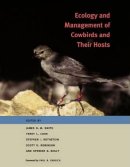
|
|
Parasitic Birds and Their Hosts: Studies in CoevolutionEditors: Stephen I. Rothstein & Scott K. Robinson
Oxford University Press
1999
"This book is the first to present a comprehensive overview of the diverse kinds of birds and interactions involved in avian brood parasitism. This phenomenon has attracted the interests of naturalists and evolutionists since Darwin, yet very few researchers applied modern evolutionary theory and experimental methods to the study of the adaptations for and against brood parasitism by parasitic birds and their hosts until 25 years ago. The amount of work being done on parasitic birds has grown at an accelerating rate in the last decade as numerous researchers have begun to pursue the study of these birds." Contents:
Preface; Dedication to Herbert Friedmann; Section 1 - Overview and Commentary; Stephen I. Rothstein and Scott K. Robinson: Ch. 1: The Evolution and Ecology of Brood Parasitism; Section 2 - Coevolution Between Cuckoos and Their Hosts; Nicholas N. Davies and Michael de L. Brooke: Ch. 2: Cuckoos Versus Hosts: Experimental Evidence for Coevolution; Hiroyoshi Higuchi: Ch. 3: Host Use and Egg Color of Japanese Cuckoos; Hiroshi Nakamura, Satoshi Kubota, and Reiko Suzuki: Ch. 4: Coevolution
Between the Common Cuckoo and Its Major Hosts in Japan: Stable Versus Dynamic Specialization on Hosts; Manuel Soler, Juan J. Soler, and Juan G. Martinez: Ch. 5: Duration of Sympatry and Coevolution Between the Great Spotted Cuckoo and its Primary Host, the Magpie; Luis Arias-de-Reyna: Ch. 6: Coevolution of the Great Spotted Cuckoo and its Hosts; Brian J. Gill: Ch. 7: Behavior and Ecology of the Shining Cuckoo Chrysococcyx lucidus; Robert B. Payne and Laura L. Payne: Ch. 8: Nestling
Eviction and Vocal Behavior in the Australian Glossy Cuckoos Chrysococcyx Basalis and C. lucidus; Section 3 - Coevolution Between Cowbirds and Their Hosts; Rosendo M. Fraga: Ch. 9: Interactions of the Parasitic Screaming and Shiny Cowbirds with a Shared Host, the Bay-winged Cowbird; Spencer G. Sealy, Diane L. Neudorf, Keith A. Hobson, and Sharon A. Gill: Ch. 10: Nest Defense by potential Hosts of the Brown-headed Cowbird: Methodological Approaches, Benefits of Defense, and Coevolution; Gustavo
H. Kattan: Ch. 11: Impact of Brood Parasitism: Why do House Wrens Accept Shiny Cowbird Eggs?; Section 4 - Models of Parasite-Host Coevolution: Equilibrium Versus Lag; Arnon Lotem and Hiroshi Nakamura: Ch. 12: Evolutionary Equilibria in Avian Brood Parasitism: An Alternative to the "Arms Race-Evolutionary Lag" Concept; Eivan Roskaft and Arne Moksnes: Ch. 13: Coevolution Between Brood Parasites and Their Hosts: An Optimality Theory Approach; Ian G. McLean and Richard F. Maloney: Ch. 14: Brood Parasitism, Recognition, and Response: The Options; Section 5 - Effects of Parasitism on Host Population Dynamics; Cheryl L. Trine, W. Douglas Robinson, and Scott K. Robinson: Ch. 15: Consequences of Brown-headed Cowbird Brood Parasitism for Host Population Dynamics; James N.M. Smith and Isla H. Myers-Smith: Ch. 16: Spatial Variation in Parasitism of Song Sparrows by Brown-headed Cowbirds; Alexander Cruz, William Post, Janes W. Wiley, Catherine P. Ortega, Tammie K. Nakamura, and John W. Prather: Ch. 17: Potential Impoacts of Cowbird Range Expansion in Florida; Section 6 - Consequences of Parasitism for the Mating Systems and Life Histories of Brood Parasites; Phoebe Barnard: Ch. 18: Variability in the Mating Systems of Parasitic Birds; Section 7 - Conspecific Brood Parasitism; Michael D. Sorenson: Ch. 19: Patterns of Parasitic Egg Laying and Typical Nesting in Redhead and Canvasback Ducks; Harry W. Power: Ch. 20: Quality Cotrol and the Important Questions in Avian Conspecific Parasitism; Anders P. Moller: Ch. 21: Density-dependent Intraspecific Nest Parasitism and Anti-parasite Behavior in the Barn Swallow Hirundo Rustica; Wendy M. Jackson: Ch. 22: Egg-discrimination and Egg-color Variability in the Northern Masked Weaver: The Importance of Conspecific Versus Interspecific Parasitism; Section 8 - Major Unresolved Questions; Stephen I. Rothstein and Scott K. Robinson: Ch. 23: Major Unanswered Questions in the Study of Avian Brood Parasitism
|
Buy from amazon.co.uk 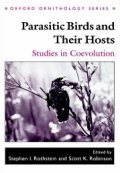
|
|
New World Blackbirds: The IcteridsAlvaro Jaramillo and Peter Burke
Illustrations: Barry Croucher, Chris Shields and Kamol Komolphalin
Princeton University Press
1999
"New World Blackbirds is a comprehensive guide to the 103 members of the family Icteridae, also known as the icterids or troupials. The icterids are a diverse family, ranging throughout the Americas from Alaska to the Caribbean and south to Cape Horn. Despite the name "blackbird," the group contains such highly colored birds as the orioles. It includes common and intensively studied species - the Red-winged Blackbird and the Brown-headed Cowbird, for example - and such rare and obscure birds as the Colombian Mountain-Grackle and the Montserrat and Martinique Orioles. Two species in the family, the Selva Cacique and the Pale-eyed Blackbird, were not described at all until as recently as the 1960s and 1970s. The thirty-nine highly detailed plates in this book depict all the species and many subspecies and age types never illustrated before. The book also contains over one hundred color range maps as well as black-and-white illustrations to aid identification. The extensive text summarizes the characteristics and natural history of each species, giving details on behavior, nesting, geographic variation, distribution, vocalizations, and in-depth plumage descriptions for all age types. Clearly written and exhaustively researched, this book will be the standard reference work for this major family of birds."
|
Buy from amazon.co.uk
Buy from amazon.com
|
|
Research and Management of the Brown-Headed Cowbird in Western LandscapesEditors: Michael L. Morrison, Linnea S. Hall, Scott K. Robinson, Stephen I. Rothstein, D. Caldwell Hahn, and D. Rich Terrell
Studies In Avian Biology 18
Cooper Ornithological Society
1999
The contents are as follows.
- Introduction - Michael L. Morrison, Linnea S. Hall, Scott K. Robinson, Stephen I. Rothstein, D. Caldwell Hahn, and Terrell D. Rich
- Section I: Cowbird ecology: factors affecting the abundance and distribution of cowbirds - Scott K. Robinson
- Review of the causes and implications of the association between cowbirds and livestock - Christopher B. Goguen and Nancy E. Mathews
- Managing riparian vegetation to control cowbirds - Cara A. Staab and Michael L. Morrison
- Cowbirds in a western valley: effects of landscape structure, vegetation, and host density - Joshua J. Tewksbury, Thomas E. Martin, Sallie J. Hejl, Timothy S. Redman, and F. Jeremy Wheeler
- Parasitism by Brown-headed Cowbirds in the shrubsteppe of eastern Washington - W. Matthew Vander Haegen and Brett Walker
- Habitat and landscape factors affecting cowbird distribution in the northern Rockies - Jock S. Young and Richard L. Hutto
- Use of different habitats by breeding Brown-headed Cowbirds in fragmented midwestern landscapes - Scott K. Robinson, Jeffrey D. Brawn, Solon F. Morse, and James R. Herkert
- The density and distribution of Brown-headed Cowbirds: the Central Coastal California enigma - Chris Farmer
- Landscape effects on cowbird occurrences in Michigan: implications to research needs in forests of the inland west - John M. Stribley and Jonathan B. Haufler
- Brown-headed Cowbirds in ponderosa pine/Douglas-fir-dominated landscapes in the northern Rocky Mountains - Sallie J. Hejl and Jock S. Young
- Scale dependence in the effects of forest coverage on parasitization by Brown-headed Cowbirds - W. M. Hochachka, T. E. Martin, V. Artman, C. R. Smith, S. J. Hejl, D. E. Andersen, D. Curson, L. Petit, N. Mathews, T. Donovan, E. E. Klaas, P. B. Wood, J. C. Manolis, K. P. McFarland, J. V. Nichols, J. C. Bednarz, D. M. Evans, J. P. Duguay, S. Garner, J. Tewksbury, K. L. Purcell, J. Faaborg, C. B. Goguen, C. Rimmer, R. Dettmers, M. Knutson, J. A. Collazo, L. Garner, D. Whitehead, and G. Geupel
- Past and present distribution of the Brown-headed Cowbird in the Rocky Mountain region - Jameson F. Chace and Alexander Cruz
- Distribution and abundance of Brown-headed Cowbirds in the wilderness of central Idaho - Anthony L. Wright
- Abundance and rates of brood parasitism by Brown-headed Cowbirds over an elevational gradient in the southern Sierra Nevada - Kathryn L. Purcell and Jared Verner
- Section II: The basis for cowbird management: host selection, impacts on hosts, and criteria for taking management action - James N. M. Smith
- Cowbird parasitism of Arizona Bell's Vireos (Vireo bellii arizonae) in a desert riparian landscape: implications for cowbird management and riparian restoration - Annalaura Averill-Murray, Suellen Lynn, and Michael L. Morrison
- What do demographic sensitivity analyses tell us about controlling Brown-headed Cowbirds? - John J. Citta and L. Scott Mills
- Lazuli Buntings and Brown-headed Cowbirds in Montana: a state-wide landscape analysis of potential sources and sinks - Erick Greene, Jennifer Jolivette, and Roland Redmond
- Demographic consequences of Brown-headed Cowbird parasitization of Lazuli Buntings - Erick Greene
- Assessing the impact of Brown-headed Cowbird parasitism in eight National Parks - Mary D. Halterman, Sarah Allen, and Stephen A. Laymon
- Impacts of Brown-Headed Cowbird parasitism on productivity of the endangered Least Bell's Vireo - Barbara E. Kus
- Costs of Brown-headed Cowbird parasitism to Willow Flycatchers - James A. Sedgwick and William M. Iko
- Range-wide impact of Brown-headed Cowbird parasitism on the South-western Willow Flycatcher (Empidonax traillii extimus) - Mary J. Whitfield and Mark K. Sogge
- Importance of predation and brood parasitism on nest success in four sparrow species in southern Californian coastal sage scrub - Kevin Ellison
- Influence of landscape and cowbird parasitism on the reproductive success of Plumbeous Vireos breeding in Colorado - Jameson F. Chace and Alexander Cruz
- A spatial and genetic analysis of cowbird host selection - D. Caldwell Hahn, James A. Sedgwick, Ian S. Painter, and Nancy J. Casna
- Common Yellowthroat brood parasitism and nest success vary with host density and site characteristics - Hildie Spautz
- Cowbird removal programs as ecological experiments: measuring community-wide impacts of nest parasitism and predation - Krista L. De Groot, James N. M. Smith, and Mary J. Taitt
- Parasitism and egg puncture behavior by Bronzed and Brown-headed Cowbirds in sympatry - Brian D. Peer and Spencer G. Sealy
- A meta-analysis of the impact of parasitism by the Brown-headed Cowbird on its hosts - Janice C. Lorenzana and Spencer G. Sealy
- Section III: Cowbird control: the efficacy of long-term control and proposed alternatives to standard control practices - Linnea S. Hall and Stephen I. Rothstein
- Is Brown-headed Cowbird trapping effective for managing populations of the endangered Southwestern Willow Flycatcher? - Mary J. Whitfield, Kristen M. Enos, and Sean P. Rowe
- Effective landscape management of Brown-headed Cowbirds at Fort Hood, Texas - G. H. Eckrich, T E. Koloszar, and M. D. Goering
- The effects of prescribed burning and habitat edges on Brown-headed Cowbird parasitism of Red-winged Blackbirds - Ethan D. Clotfelter, Ken Yasukawa, and Richard D. Newsome
- Cowbird trapping in remote areas: alternative control measures may be more effective - Kirsten J. Winter and Sharon D. McKelvey
- Golden-cheeked Warbler fatality in a cowbird trap - Kristin K. Terpening -
- Literature cited
|
Buy from amazon.co.uk 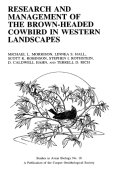
|
|
Cowbirds and Other Brood ParasitesCatherine P. Ortega
University of Arizona Press
1998
"The Brown-headed Cowbird is known to use the nests of more than 200 other bird species, and cowbirds in general are believed to play a role in the decline of some migratory songbird populations. These brood parasites - birds that lay their eggs in the nests of others - have long flourished in North America. In this timely book, Catherine Ortega summarizes and synthesizes a wealth of information on cowbirds from around the world that has appeared since the publication of Herbert Friedmann's classic 1929 monograph on these birds. Most of this information has appeared in the last quarter-century and reflects advances in our understanding of how brood parasitism influences, and is influenced by, host species. Ortega shows that in order to manage cowbirds without further damaging delicate balances in host-parasite relationships, it is necessary to understand such factors as behavior, reproduction, population dynamics, and response to landscape patterns. She examines and explains the origin, evolution, and costs of brood parasitism, and she discusses the philosophical and ecological considerations regarding the management of cowbirds - a controversial issue because of their perceived influence on threatened and endangered birds. Because brood parasitism has evolved independently in various bird families, information on this adaptive strategy is of great ecological interest and considerable value to wildlife management."
|
Buy from amazon.co.uk 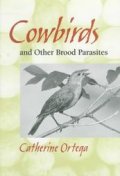
|
|
The Avian Brood Parasites: Deception at the NestPaul A. Johnsgard
Oxford University Press
1997
"The evolutionary, ecological and behavioral questions posed by obligate brood parasites are among the most intriguing of all contemporary ornithological topics. Avian brood parasites lay their eggs in the nests of other birds and may be a major contributing factor driving several species of songbirds to near extinction. As one of the first books to present a comprehensive overview of this fascinating phenomenon, this work discusses the comparative biology and co-evolutionary adaptations exhibited by the five families of birds that engage in such behavior. Several chapters dealing with the comparative biology of both intraspecific and interspecific brood parasites, are followed by individual accounts of all known species - nearly 100 altogether, primarily cowbirds and cuckoos. Some of the more remarkable behavioral and structural adaptations of these birds include egg mimicry, juvenile mimicry, elimination by starvation or actual attack of other nestlings or host eggs, and even the learning and partial mimicry of host song traits. An extended glossary, a list of Latin names, 400 literature citations and range maps of all parasitic species discussed are also included. Detailed line drawings by the author enhance this synthesis of biological and ecological information."
Includes a section on Honeyguides which discusses 17 species. |
Buy from amazon.co.uk 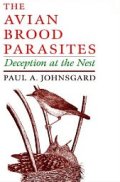
|
|
Orioles, Blackbirds, and Their Kin: A Natural HistoryAlexander F. Skutch
University of Arizona Press
1996
"From blackbirds and orioles to meadowlarks, grackles, and cowbirds, the variety and variation shown by members of the family Icteridae is legend. The family exhibits great diversity in size and coloration, mating and nest building, and habits and habitats. This group of 94 New World species once known as the troupials is well represented in backyards across America; yet most icterids are tropical or semi-tropical species that remain largely unstudied. The least known of these species are perhaps best known to Alexander Skutch, who has studied birds in a Costa Rican tropical valley for more than half a century. In this fascinating book - the first devoted exclusively to the icterids - he combines his own observations with those of other naturalists to provide a comparative natural history and biology of this remarkable family of birds. Devoting a separate chapter to each major group or genus, he delineates the outstanding characteristics of each and includes observations of little-studied tropical species such as caciques and oropendolas. Orioles, Blackbirds, and Their Kin is an eminently readable natural history in the classic style. Enhanced by 31 scratchboard illustrations, this book will delight nature enthusiasts everywhere with its fascinating exposition of avian diversity. Because so much of the published information on the icterids is widely scattered, Skutch's painstaking compilation has created a valuable reference work that will provide students and researchers with a wealth of new insights into the tropical members of this New World family."
|
Buy from amazon.co.uk
Buy from amazon.com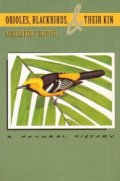
|
|
The Parasitic Cowbirds and their HostsHerbert Friedmann, L.F. Kiff
Proceedings, Volume 2, Number 4
Western Foundation of Vertebrate Zoology
1985
|
 |
|
A Further Contribution Of Knowledge Of The Host Relations Of The Parasitic CowbirdsHerbert Friedmann, Lloyd F. Kiff, Stephen I. Rothstein
Smithsonian Contributions To Zoology Number 235
Smithsonian Institution, United States National Museum
1977
From the introduction: "The present paper brings together a vast amount of new information documenting and clarifying the relations existing between the many kinds of victims of the several cowbird species and their respective parasites. It is based on observational and specimen data, supplemented by the results of still continuing experiments conducted by one of us (S.I.R.) over a number of years. It also critically reviews data available from the recent work of others in this currently very active field of research. Even the mere accumulation of additional instances of cowbird parasitism on some of the less well documented host species, while often fragmentary in nature and not always conducive to immediate biological conclusions, has a value for investigators of those individual species as well as a cumulative value and meaning in the overall problems of brood parasitism.
|
Buy from amazon.co.uk 
|
|
Host Relations Of The Parasitic CowbirdsHerbert Friedmann
Bulletin 233
Smithsonian Institution, United States National Museum
1963
A 275 page study.
|
Buy from amazon.co.uk 
|
|
Food Of The Bobolink, Blackbirds, And Grackles
F.E.L. Beal
Illustrations: J.L. Ridgway
Division Of Biological Survey Bulletin No. 13
US Department of Agriculture
Government Printing Office
1900
From the introduction: In this bulletin are discussed the food habits of the bobolink, the cowbird, the yellow-headed blackbird, the red-winged blackbird, the California red- winged blackbird, the rusty blackbird, Brewer's black- bird, the crow blackbird, and the boat-tailed grackle. These comprise all the important members of the group with the exception of the meadowlarks and orioles. 1 One or more of these species may be found at some time of the year in every State and Territory. As they are much given to nesting and feeding about farms and stock yards or to visiting outlying grainfields and pastures, the character of their food becomes a question of considerable importance to the cultivator.
|
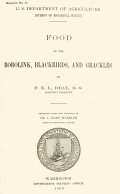
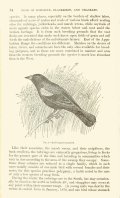 |
|